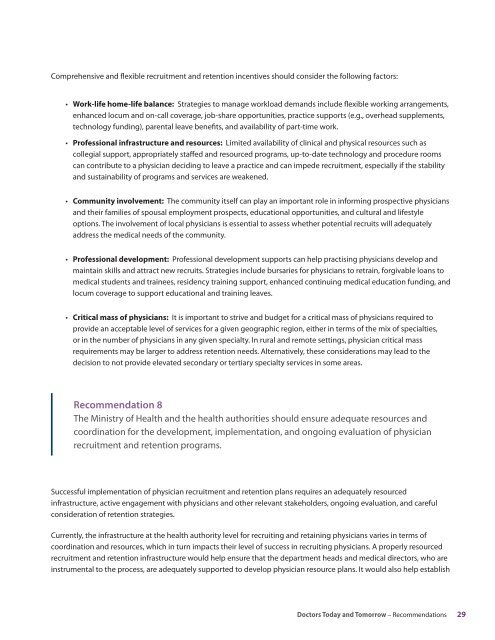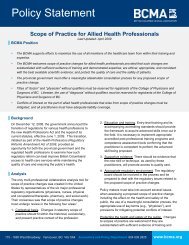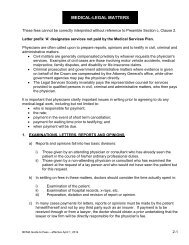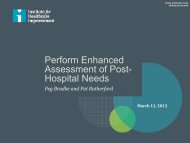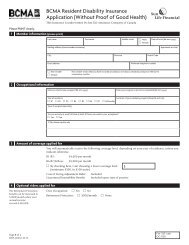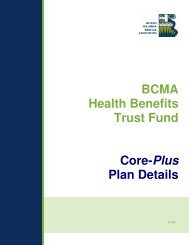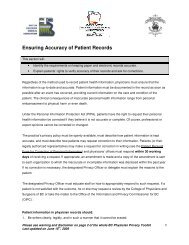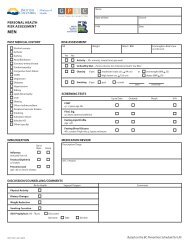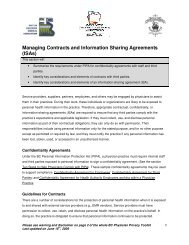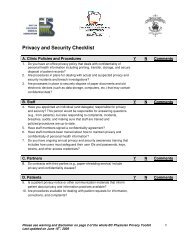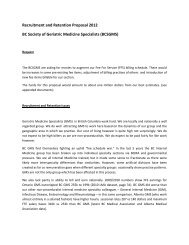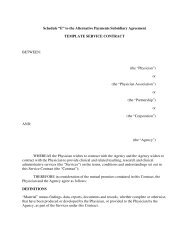Doctors Today and Tomorrow - British Columbia Medical Association
Doctors Today and Tomorrow - British Columbia Medical Association
Doctors Today and Tomorrow - British Columbia Medical Association
You also want an ePaper? Increase the reach of your titles
YUMPU automatically turns print PDFs into web optimized ePapers that Google loves.
Comprehensive <strong>and</strong> flexible recruitment <strong>and</strong> retention incentives should consider the following factors:<br />
• Work-life home-life balance: Strategies to manage workload dem<strong>and</strong>s include flexible working arrangements,<br />
enhanced locum <strong>and</strong> on-call coverage, job-share opportunities, practice supports (e.g., overhead supplements,<br />
technology funding), parental leave benefits, <strong>and</strong> availability of part-time work.<br />
• Professional infrastructure <strong>and</strong> resources: Limited availability of clinical <strong>and</strong> physical resources such as<br />
collegial support, appropriately staffed <strong>and</strong> resourced programs, up-to-date technology <strong>and</strong> procedure rooms<br />
can contribute to a physician deciding to leave a practice <strong>and</strong> can impede recruitment, especially if the stability<br />
<strong>and</strong> sustainability of programs <strong>and</strong> services are weakened.<br />
• Community involvement: The community itself can play an important role in informing prospective physicians<br />
<strong>and</strong> their families of spousal employment prospects, educational opportunities, <strong>and</strong> cultural <strong>and</strong> lifestyle<br />
options. The involvement of local physicians is essential to assess whether potential recruits will adequately<br />
address the medical needs of the community.<br />
• Professional development: Professional development supports can help practising physicians develop <strong>and</strong><br />
maintain skills <strong>and</strong> attract new recruits. Strategies include bursaries for physicians to retrain, forgivable loans to<br />
medical students <strong>and</strong> trainees, residency training support, enhanced continuing medical education funding, <strong>and</strong><br />
locum coverage to support educational <strong>and</strong> training leaves.<br />
• Critical mass of physicians: It is important to strive <strong>and</strong> budget for a critical mass of physicians required to<br />
provide an acceptable level of services for a given geographic region, either in terms of the mix of specialties,<br />
or in the number of physicians in any given specialty. In rural <strong>and</strong> remote settings, physician critical mass<br />
requirements may be larger to address retention needs. Alternatively, these considerations may lead to the<br />
decision to not provide elevated secondary or tertiary specialty services in some areas.<br />
Recommendation 8<br />
The Ministry of Health <strong>and</strong> the health authorities should ensure adequate resources <strong>and</strong><br />
coordination for the development, implementation, <strong>and</strong> ongoing evaluation of physician<br />
recruitment <strong>and</strong> retention programs.<br />
Successful implementation of physician recruitment <strong>and</strong> retention plans requires an adequately resourced<br />
infrastructure, active engagement with physicians <strong>and</strong> other relevant stakeholders, ongoing evaluation, <strong>and</strong> careful<br />
consideration of retention strategies.<br />
Currently, the infrastructure at the health authority level for recruiting <strong>and</strong> retaining physicians varies in terms of<br />
coordination <strong>and</strong> resources, which in turn impacts their level of success in recruiting physicians. A properly resourced<br />
recruitment <strong>and</strong> retention infrastructure would help ensure that the department heads <strong>and</strong> medical directors, who are<br />
instrumental to the process, are adequately supported to develop physician resource plans. It would also help establish<br />
<strong>Doctors</strong> <strong>Today</strong> <strong>and</strong> <strong>Tomorrow</strong> – Recommendations 29


